Countryside Corner
Neighborly Garden News

Issue 118
February 2022
Dear readers; please visit our website: www.countrysidelandscape.net for the safety measures we have in place during this pandemic.
Trends in Garden Design for 2022
The trendiest thing you can do in your garden is whatever makes you happy! The forecast for 2022? Intention and purpose in the garden, consider how everything—each plant, piece of garden art or furniture, structure, material, pot, and more—contributes to your entire outdoor space.
- Include Plants that Transport You to the Tropics: Though tropical plants have always been a favorite; nurseries have seen a recent boost in popularity. If you’re new to tropical plants, here are some beauties to get you started: Cannas have jungle-like leaves and upright stems with blooms in colors ranging from pale pastels to vibrant oranges and reds. Caladiums, which are available in sun and shade loving varieties, have large, colorful, foliage. Rose-of-Sharon is a hardy perennial Hibiscus, which can add a tropical feel to your garden. Or purchase a tropical Hibiscus, and take it in as a winter houseplant, after enjoying its summer-long blooms. (I have 4 Hibiscus that make the indoor/outdoor move each spring and fall)
- Blur the line between indoors and out: Set up garden rooms to extend your living space, providing you a place to get cozy while enjoying fresh air. Screen areas using tall shrubs or hanging plants to create the sense of enclosure you get indoors. Get comfy. A lounge chair or hammock will make your space more hospitable.
- Design a garden with dark foliage: Plants with bright flowers or vibrant foliage colors such as silver or chartreuse are standouts on their own. But the secret to really making them pop is dark foliage for contrast. Here are just a few stunners: A beautiful black leaved Heuchera, ‘Primo Black Pearl’ makes an impressive backdrop for any light-colored plant or flower. The dramatic Ninebark, ‘Summer Wine Black’ contrasts beautifully with its pinkish-white flowers. Annual Sweet Potato Vine ‘Blackie’ or ‘Sweet Caroline Bewitched’ is a workhorse in hanging pots or containers.
- Taking your Food from Start to Finish: For some gardeners, eating what you sow isn’t a new concept. But others are just discovering the many benefits: Ensuring clean eating; you control the type of soil, fertilizer, and seeds that are used. Saving money; buying 100 seeds is sometimes less expensive than buying one transplant. Experiencing joy; taking your food from seed to table is fun. Involving kids; kids are more likely to eat food they’ve grown. Reducing your plastic use; you’ll be purchasing less produce at the grocery store.
- Gardening for Wildlife: Reduce or replace your lawn with alternatives that do more to support pollinators, wildlife, and soil health. Include water features that provide a place for wildlife to visit. Use a diverse mix of plants that thrive in your region. Gardeners have been striving to make their gardens more wildlife friendly for years. But it’s becoming more common for gardeners to be more intentional about every single thing they do in their gardens.
- Maximize Balconies and Porches: Staying at home more has led people to become more and more creative with their spaces. It’s truly incredible to see how many plants can fit in even just 30 square feet, or less! Here are some ways to fit a lot of plants into a balcony garden or other small outdoor space: Include large pots that can handle multiple plants. Install shelves for smaller plants such as herbs and other annuals. Attach chicken wire to your railing to grow vines or other climbing plants. Hang pots from the roof of your space, if possible. Put plant hangers on railing. Mix edibles and ornamental plants in containers to conserve space.
- Creating gardens for Peace of Mind: By now, most of us know that gardens are good for our mental health. That’s why gardeners are becoming more intentional about what elements they add to their gardens, carefully selecting pieces that will draw them in. Get sentimental; if there’s a plant that evokes fond memories of a loved one, find a place for it. Include colors that make you feel good. Decide which colors you do and do not want and keep that in mind as you select plants. Create sensory connections; include scented plants near spaces where you frequently spend time. Incorporate plants with soft textures near pathways so they brush up against you as you walk through your garden. Add the sound of water or plants such as ornamental grasses, that make a lovely rustling sound in a breeze.
February’s ‘to-do’ list
Whether we enjoy it or not, cold weather has finally arrived. As I write this newsletter for February, we are under a winter storm watch. My cousin from Georgia called me, asking if I was alright, experiencing all this cold weather and snow. I had to chuckle a bit, when we first moved to New England snowstorms leaving 20+ inches of snow seemed to be the norm. Lately we have been getting much less snowfall, more freezing rain and ice. Still, it’s better to be prepared for whatever winter weather may bring us. Be sure your gardens and yard are ready for the harshest part of winter.
Check to see that protective mulch has not been heaved up and off your garden beds. If you wrapped your shrubs in protective covering, make sure it has not become loose and pulled away, leaving vulnerable plants exposed to harsh winds. Is there any sign of animal damage/browsing? Hardware cloth wrapped around the trunk or stems can limit what damage they can do. There’s still an opportunity to apply animal repellent, if deer and rabbits have been browsing on plants in your yard.
Late winter storms are often wet and icy. Remember to shake off evergreen branches weighed down by ice and snow. If you should happen to get some broken branches, be sure to prune off the stump cleanly. A ragged tear will inhibit proper healing and invite infection from pathogenic organisms.
Have you noticed; we are moving back into the light? As of February 1st, we will be experiencing almost 10 hours of daylight; by the end of this month, we will be receiving over 11 hours of light. I’m sure you have noticed the change; your plants have noticed too. Don’t forget to resume diluted weekly applications of fertilizer for your houseplants; give them a half strength feeding with liquid fertilizer.
Late winter is the best time to prune orchid fruit: Pears, Apples, Cherries, and Peaches. It is a necessary step in maintaining productivity for fruit trees. Pruning helps direct the plant’s energy into producing desirable fruit, by removing the extraneous growth they can produce every year. You can see that some trees will naturally produce a lot of twiggy, upwards growing ‘water shoots’ along the length of their main branches. Leaving these in place is not good for the overall health and productivity of the fruit tree. It is better to remove them when they are small, before they begin to dominate the tree.
A good way to beat those winter blues is to get some greenery into your life. An easy kid-friendly project is forcing branches of spring flowering shrubs and trees into early bloom. Snip branches on a 45’ angle and submerge in water overnight. Place the branches in a sturdy, heavy bottomed vase and store the branches in a cool location until the buds begin to open. Change the water every few days for longer vase-life. Best candidates for forcing are: Forsythia, Crabapples, Cherries, Pussy Willows, and flowering Quince.
Another way to beat the winter doldrums is to visit one of our delightful indoor gardens or flower shows.
Smith College Spring Bulb Show, Mar. 5th – 20th 2022, Lyman Plant House, 16 College Lane, Northampton, MA.
https://garden.smith.edu/plants/lyman-conservatory/seasonal-shows/spring-bulb-show
The Connecticut Flower and Garden Show, Feb. 24th – 27th 2022 at the Connecticut Convention Center, 100 Columbus Blvd, Hartford, CT. https://ctflowershow.com/
Inspect and prepare your garden tools. Nothing beats a sharp blade to speed up garden chores like deadheading, pruning, and hoeing. Before your garden life becomes hectic, take a morning to lubricate and hone your hardworking tools. Inventory your garden essentials, and set reminders to order soil, compost, or mulch, and to schedule the ‘heavy jobs’ like gutter cleaning, spring clean ups, and lawn renovation.
Next month I will start planting my veggie and flower starts; do you have your seed starting equipment and planting essentials ready for spring? Since I reuse my plastic plant pots, I make sure to give them a thorough cleaning before planting time. I make a 10% bleach/water solution to sterilize my pots; nothing more disappointing than to lose your plants to disease before they even get into the ground.
Need a hand with winter chores? Please contact our office to schedule winter services: (413) 458-5586, info@countrysidelandscape.net
Understanding fertilizer numbers; what does N-P-K mean?
Every fertilizer label is imprinted with 3 numbers that stand for the ratio or proportion of Nitrogen, Phosphorus and Potassium (N-P-K) in the product. The numbers reflect the nutrients percentage by weight in the bagged fertilizer.
This figure is handy to know if you’ve had a recommendation for a certain quantity of Nitrogen to apply to your soil. For instance a 12 lb bag of 10-5-10 (12lbs x .10 = 1.2) would have 1.2 lbs of actual Nitrogen.
Of the 17 nutrients essential to all plant life these 3, N-P-K, are required in the greatest amounts. Because plants use larger quantities of these 3 nutrients, they have to be replenished. As Nitrogen moves freely through the soil, water can leach out this mineral through daily irrigation or heavy rains.
Nitrogen (N) is responsible for the lush vegetative growth and green color in lawn and leafy plants. Without enough Nitrogen plants will be stunted and have a yellowish cast to them. Too much Nitrogen will promote excess leafy growth, and no flowering.
Phosphorus (P) promotes strong root development and fruit, flower and seed production. Phosphorus also helps plants metabolize other nutrients efficiently. A lack of Phosphorus will cause poor root development, and scarce or no flower development.
Potassium (K) will enhance overall growth within the plant. It acts as a modulator; balancing the rate of top and root growth. Potassium acts like a general tonic; elevating cold and drought tolerance, and resistance to pests and diseases.
For best vegetables and tomatoes; look for higher second (P) and third (K) numbers. Flower bulbs need to root quickly, so look for products with a higher middle (P) number. The flower and leaves are already formed within the bulb for next year’s bloom.
Thinking ahead…
Utilizing groundcover type plants as living mulch can eliminate the need for yearly application of bark mulch or chips. The initial investment of time and money will pay off with years of beauty when the groundcover becomes established. Many varieties produce flowers, and have nice fall coloration; so much more interesting than plain mulch.
Epimedium spp. is called ‘Barrenwort’ because it blooms before the leaves come out. The flowers remind me of helicopter wings and come in shades of pink, purple, yellow or white. It’s a vigorous, deer resistant, plant suitable for dry shade. Grows 10-20” tall depending on the species.
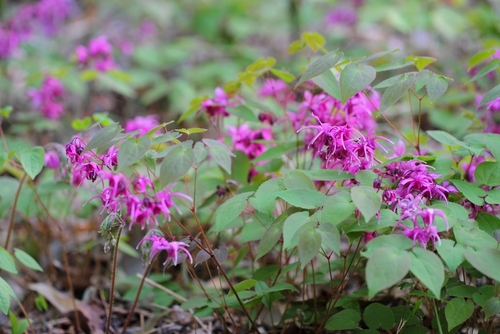
Barrenwort flowers

Barrenwort foliage in Autumn
Lamium galeobdolon; common name: ‘Yellow Archangel’, the cultivar ‘Hermann’s Pride’ has silver and green metallic-like leaves that get more intensely colored in the shade. The butter-yellow tubular flowers are held on 12” spikes during mid-summer. This groundcover is very adaptable, good for sun or part shade, and deer resistant.

Lamium galeobdolon in flower

Lamium galeobdolon foliage
Sedum kamtschaticum or ‘Russian stonecrop’ is great for hot and dry, full sun areas. Only 6” tall the bright gold flowers are held on candy red stems, its leaves turn purple in the fall. Sedums are generally very rugged, deer resistant, and suitable for rocky areas and banks.
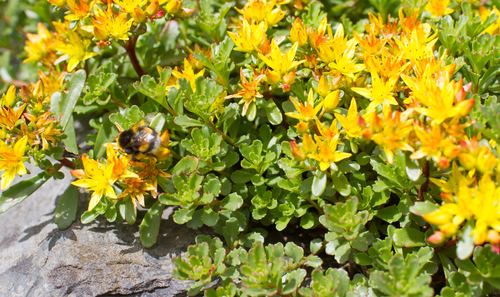
Sedum kamtschaticum
Phlox subulata or ‘Moss Phlox’ is also called creeping phlox, a welcome sight in May. Sometimes covering whole slopes; it can form a very dense carpet. Moss Phlox likes sandy, well-drained soil, tolerant of low fertility, needs full sun. Shades of blue, pink purple and white, and bicolor. Moss Phlox grows to 6” tall and is considered deer resistant.
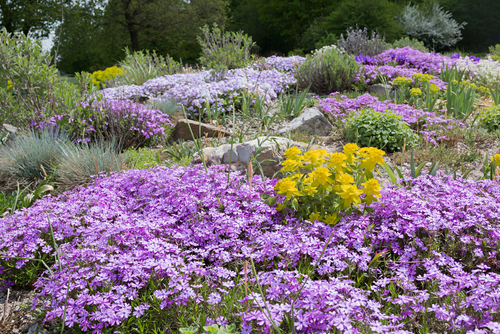
Phlox subulata
Tiarella cordifolia; the ‘Allegheny Foamflower’ is a hardy native to our moist woodlands. The white or pink flowers look like frothy stars held up above the foliage on slender spikes. Tiarella blooms for 6 weeks through mid to late spring. Grows 12-15” tall, deer resistant.
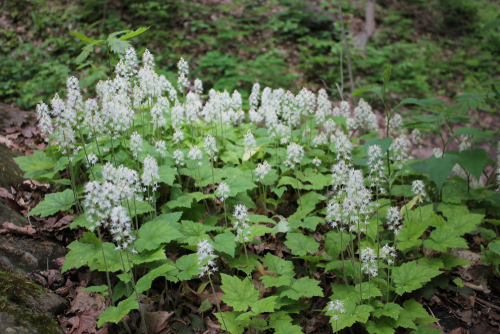
Tiarella cordifolia groundcover
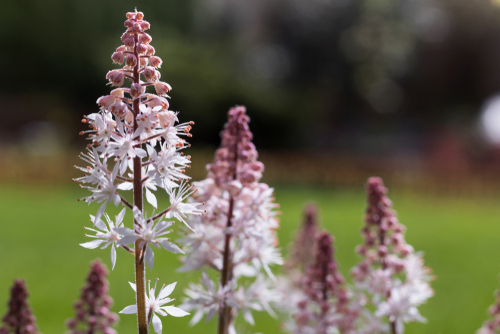
Tiarella cordifolia flower detail